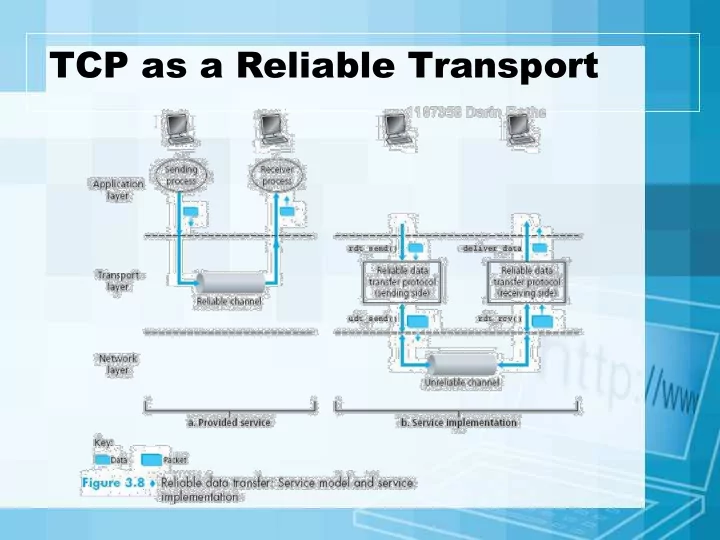

TCP as a Reliable Transport
How things can go wrong… • Lost packets • Corrupted packets • Reordered packets • …Malicious packets…
Requirements for Reliability • Error Detection • Receiver Feedback • Retransmission
Requirements for Reliability • Error Detection – Checksum • Receiver Feedback – ACK – acknowledgment – NAK – negative acknowledgment • Also missing ACK • Retransmission – Sender resends segment with NAK or missing ACK
Stop and Wait RTT – Round Trip Time
Packet Loss
Sliding Window - Pipelined • Requires Buffering on each end
TCP Data Transfer Specifics • Data transferred as a stream of octets • Data is transferred in segments, but acknowledged at the octet level • Full duplex – data can be transferred in either direction, or both • Both endpoints of connection must maintain buffers/windows for both sending and receiving
Sender’s Window • 1, 2 have been sent and acknowledged • 3 – 6 sent but not acknowledged • 7 – 9 have not been sent but can be without delay • 10 and higher will not be sent until window moves
Window Advertisement • Window size can vary over time • Receiver sends a windows size with acknowledgement that indicates how many octets it is willing to accept • Allows flow control • An advertisement of 0 will halt transfer
Acknowledgement • Acknowledgements are cumulative – Acknowledgement of any octet implies receipt of all previous octets – ++ Simple – ++ Lost acknowledgements will not necessarily result in retransmission
Acknowledgement • Acknowledgements are cumulative – Acknowledgement of any octet implies receipt of all previous octets
Acknowledgement • Acknowledgements are cumulative – Acknowledgement of any octet implies receipt of all previous octets What if timeout was here? – Think (30 s) – Pair (30 s) – Shair
Timeout and Retransmission • What do we use for a timeout? – LAN – round-trip time for ACK might be ms – Internet – 100x – Varies over time
Adaptive Retransmission • Round-trip time (RTT) is monitored for each transmission/ACK 0 ≤ α < 1 Recommended value of α = 0.128 [RFC 6298] Recommended β is 0.25
Congestion Control • Flow control is a function of the receiver and its ability to accept data • Congestion control is implemented by the sender to avoid excessive unsuccessful transmission (collapse)
New Variable - cwnd • Congestion window Un-acknowledged bytes – cwnd – congestion window – rwnd – receive window We can send up to cwnd bytes per RTT period
cwnd • Average transmission rate is roughly cwnd/RTT bytes/sec • By manipulating cwnd, transmission rate can be controlled
Congestion Detection • Essentially loss of segments – Retransmission on timeout – Fast retransmit on duplicate ACK • Adjust cwnd – Decrease when a segment is lost – Increase when [consistent] ACKs are received • Continue to increase until a segment is lost, then backoff
TCP Slow Start • Start with a small cwnd (one MSS)
cwnd Over Time
Lab Tomorrow • Wireshark • Your TCP Server / Client (from Lab #2)
The content of this video is based in part on lecture slides from a very good textbook, and used with the author’s permission : Computer Networking: A Top-Down Approach , 6e, by Jim Kurose and Keith Ross Publisher: Pearson, 2013 It is also based on slides provided by Dr. Darrin Rothe
Recommend
More recommend